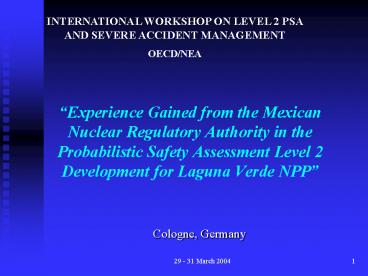PowerPoint PPT Presentation
Title:
1
Experience Gained from the Mexican Nuclear
Regulatory Authority in the Probabilistic Safety
Assessment Level 2 Development for Laguna Verde
NPP
INTERNATIONAL WORKSHOP ON LEVEL 2 PSA AND SEVERE
ACCIDENT MANAGEMENT OECD/NEA
- Cologne, Germany
2
PSA for Laguna Verde NPP
- Individual Plant Examination
- Mexican Regulatory Authority developed an
independent PSA level 2 model. - Review Process
3
Level 2 PSA Methodologies
- Utility used the methodology of small event
tree-large fault tree developed by the Electrical
Power Research Institute (EPRI) of the USA - CNSNS used
- NUREG-1150 (Accident Progression Event Tree, APET)
4
Laguna Verde Plant / Containment Characteristics
- Two BWR/5, 2027 MWt
- Unit 1 began its commercial operation in 1990 and
Unit 2 in 1995. - Fuel mass 92 041 kg
- Zirconium mass 34908 kg
- MARK II Containment
5
Laguna Verde Nuclear Power Plant
Mark II Containment
6
Laguna Verde. Plant / Containment Characteristics
- Containment volume 10907 m3
- Power / Containment volume 0.18 MWt/m3
- Power / Suppression pool volume 0.63 MWt/m3
- Several systems to supply coolant injection to
the core. - Depressurization of the vessel
7
Laguna Verde. Plant / Containment Characteristics
- Internal design pressure 3.16 kg/cm2
- Estimated containment failure pressure
- 11.6 kg/cm2
- Venting pressure 4.2 kg/cm2
- 3 Diesel Generators
8
Regulatory Authority PSA level 1
- PSA LEVEL 1
- CDF 5.65E-5 reactor / year
- Station Black Out (43)
- LEVEL 1 / 2 INTERFACE
- 25 Plant Damage States, which resume the possible
plant states at the moment of core damage.
9
CNSNS, PSA level 2 Methodology
- Accident Progression Event Tree
- 131 Questions about possible events
- Phenomenological aspects
- Systems availability
- Operator interactions
- Conditions before core damage
- Containment conditions before and after vessel
breach - Containment failure modes
- MELCOR code was used to support the APET.
10
Accident Severe Phenomenology for LV NPP
- In-vessel
- Generation of hydrogen
- Melt progression
- Ex vessel
- Direct Containment Heating
- Steam Explosions
- Core Concrete Interaction
- Fission Products Transport
- Mitigation by suppression pool scrubbing
11
Structural Containment Analysis
Ultimate Capacity of the Containment
- Containment Failure Modes
- Leak
- Depressurization of the containment after 2 hrs.
(A92.9 cm2) - Rupture
- Depressurization of the containment before or at
2 hrs. (A929 cm2)
Temperature (oK) Pressure (Kg/cm2)
303 11.6
403 11.1
489 11.1
573 6.8
12
Accident Progression Event Tree
- The quantification process was performed by means
of the EVNTRE computer code - Event Progression Analysis Code, NUREG/CR-5174,
Sandia National Laboratories. - More than 1000 accident progression paths
13
Accident Progression Event Tree
- Binning/Rebinning
- 33 initial characteristics of accident
progression paths. - 13 final characteristics (bins).
14
Source Term Analysis
- LVSOR (series XSOR)
- Parametric equation based on mass conservation
- Phenomenon
- Events related with the accident progression
15
Releases Categories
- Timing
- Early (before 6 hours)
- Intermediate (6 to 24 hours)
- Late (after 24 hours)
- A mount of fission product releases
- High (more than 10 of Cs-I)
- Moderate (1 to 10)
- Low (less than 1)
16
Individual Plant Examination
- 9 PDS
- Containment Event Tree developed for the Accident
Progression Analysis. - 50 to 400 accident progression paths for every
Containment Event Tree - Codes CAFTA and MAAP
17
Containment Failure Mode for LVNPP (CNSNS study)
18
LVNPP PSA Level 2 Results
CNSNS IPE
Containment failure frequency 5.25E-5 2.59E-5
Conditional probability of vessel breach at high pressure given core damage 0.14 0.27
Conditional probability of containment failure by leak or rupture 0.55 0.6
Conditional probability of containment venting 0.37 0.06
Conditional probability of no containment failure 0.07 0.19
Conditional probability of containment bypass -- 0.14
19
LVNPP PSA Level 2 Results
CNSNS IPE
Conditional probability of containment failure before vessel breach 0.36 0.15
Conditional probability of containment failure at vessel breach 0.14 ---
Conditional probability of containment failure after vessel breach 0.42 0.66
Conditional probability of no containment failure 0.07 0.19
20
LVNPP PSA Level 2 Results
CNSNS IPE
Large Early Release Frequency 1.02E-08 3.4E-7
Conditional probability of Cs and I release greater or equal to 10 0.74 0.36
Conditional probability of Cs and I release between 1 and 10 0.05 0.13
Conditional probability of Cs and I release lower than 1 0.13 0.32
21
LVNPP PSA Level 2 Results
CNSNS IPE
Conditional probability of releases in an early period 0.07 0.05
Conditional probability of releases in an intermediate period 0.7 0.67
Conditional probability of releases in a late period 0.17 0.09
Conditional probability of no containment failure 0.07 0.19
22
Categories of fission products releases
IPE
CNSNS
HE
NL
1
16
LE
4
ML
LL
HE
NL
0
LL
17
LI
0
7
0
MI
9
2
HI
ME
49
3
LI
8
LE
HL
HI
1
7
MI
59
HL
ME
ML
0
16
1
0
23
Experience Gained During the Review Process
- The experience gained during the development of
the regulatory PSA allow us to focus the review
process on those important features of the back
end analysis. - Timing of phenomenological issues
- Parameter figures
- The usage of simulations code results
- Containment structural analysis
- Source term analysis
24
Review Process
- Modifications and improvements
- CET structure
- Fault tree models
- Input deck of MAAP code
- Conatainment filure modes inclution
25
CONCLUSIONS
- Largest source terms in both studies are
associated to Station Blackout scenarios - The overpressure is the dominant containment
failure mode, and the location is in the drywell. - In general both studies show similar trends in
the evolution of the accident progression and
source term released. - The small containment event tree method is more
traceable, and considerably easier to review - IPE did not characterize uncertainty.

